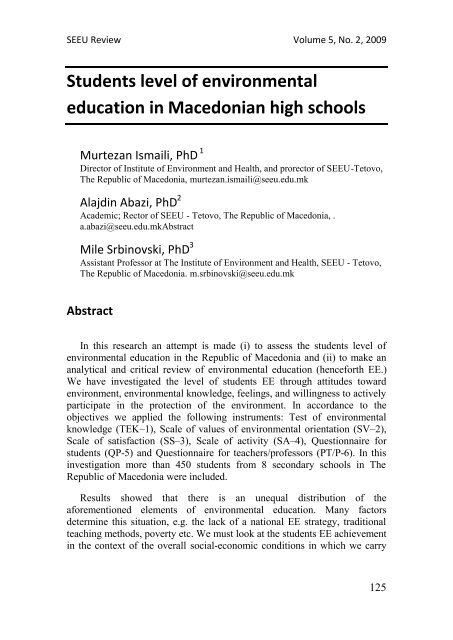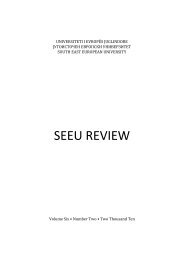SEEU Review vol. 5 Nr. 2 (pdf) - South East European University
SEEU Review vol. 5 Nr. 2 (pdf) - South East European University
SEEU Review vol. 5 Nr. 2 (pdf) - South East European University
You also want an ePaper? Increase the reach of your titles
YUMPU automatically turns print PDFs into web optimized ePapers that Google loves.
<strong>SEEU</strong> <strong>Review</strong> Volume 5, No. 2, 2009<br />
Students level of environmental<br />
education in Macedonian high schools<br />
Murtezan Ismaili, PhD 1<br />
Director of Institute of Environment and Health, and prorector of <strong>SEEU</strong>-Tetovo,<br />
The Republic of Macedonia, murtezan.ismaili@seeu.edu.mk<br />
Alajdin Abazi, PhD 2<br />
Academic; Rector of <strong>SEEU</strong> - Tetovo, The Republic of Macedonia, .<br />
a.abazi@seeu.edu.mkAbstract<br />
Mile Srbinovski, PhD 3<br />
Assistant Professor at The Institute of Environment and Health, <strong>SEEU</strong> - Tetovo,<br />
The Republic of Macedonia. m.srbinovski@seeu.edu.mk<br />
Abstract<br />
In this research an attempt is made (i) to assess the students level of<br />
environmental education in the Republic of Macedonia and (ii) to make an<br />
analytical and critical review of environmental education (henceforth EE.)<br />
We have investigated the level of students EE through attitudes toward<br />
environment, environmental knowledge, feelings, and willingness to actively<br />
participate in the protection of the environment. In accordance to the<br />
objectives we applied the following instruments: Test of environmental<br />
knowledge (TEK–1), Scale of values of environmental orientation (SV–2),<br />
Scale of satisfaction (SS–3), Scale of activity (SA–4), Questionnaire for<br />
students (QP-5) and Questionnaire for teachers/professors (PT/P-6). In this<br />
investigation more than 450 students from 8 secondary schools in The<br />
Republic of Macedonia were included.<br />
Results showed that there is an unequal distribution of the<br />
aforementioned elements of environmental education. Many factors<br />
determine this situation, e.g. the lack of a national EE strategy, traditional<br />
teaching methods, poverty etc. We must look at the students EE achievement<br />
in the context of the overall social-economic conditions in which we carry<br />
125

















